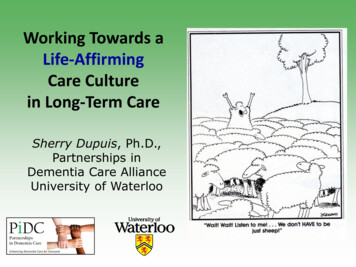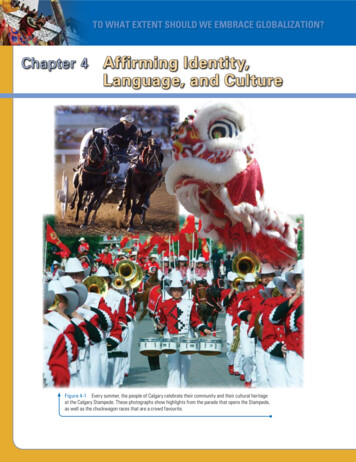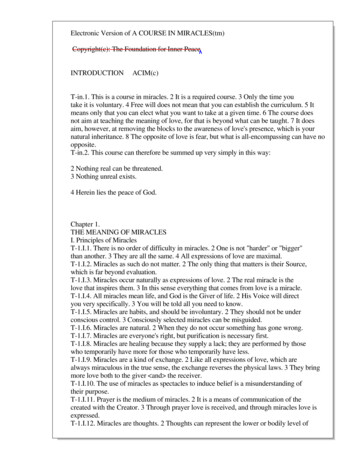
Transcription
Working Towards aLife-AffirmingCare Culturein Long-Term CareSherry Dupuis, Ph.D.,Partnerships inDementia Care AllianceUniversity of Waterloo
In nursing homes, assisted living facilities andadult day programs we supply our elders withthe necessities of survival, but they are toooften deprived of the necessities of LIVING(Fagan, 2003, p. 127)
BeingMeBeingWithSeekingFreedomFindingBalanceMaking aDifferenceHavingFunGrowing andDeveloping
BeingMe
BeingWith
SeekingFreedom
FindingBalance
MakingaDifference
Growing&Developing
HavingFun
Objectives Describe what culture change is and is not Explore some of the challenges andbarriers associated with creating a cultureof LIVING Identify specific strategies to supportsustainable culture change Describe some of the possibilities oftransformational change
Culture Change is an organic on-going and evolving process involves critical examination of thelanguage, values, assumptions, attitudes,ways of relating, practices, approaches, andpolicies embedded within an organisation requires specific plans and actionstargeted at transforming the culture fromthe current medical/institutional model ofcare to a relational/community model ofLIVING
ureOrganisationPracticeFigure 1: Interdependencies Between Words, Activities and Relationships(Kemmis & McTaggart, 1988)
Culture Change is NOT an end product or outcome solely a quality improvement initiative a specific program or model of carethat is implemented a one-size fits all approach top-down mandate imposed by others easy
Institutional, Medical Model Hierarchical structure/department silos Healthcare provider viewed as expert Disease-centred with a primary focus on physicalcare Focus on traditional care and “treatments” Scheduled programs and routines Reliance on outcome measures Exclusive decision-making processes
Culture Change Values Supporting choice and self-determination Maintaining dignity and respect Nurturing body, mind and spirit Knowing and focusing on the person Living life to the fullest Supporting continuing abilities, gifts, talents, aspirations Creating enabling, normalizing environments Building close interdependent relationships Prioritizing collaborative decision-making Offering flexibility
Political ticesLocal CommunityAdapted HATCh Model, Quality Partners of Rhode Island (2006)
Small Group Reflection #1 Together identify specific threats to creatinga culture of LIVING for older adults andpersons living with dementia that you knowof or have witnessed/experienced atdifferent relational layers (i.e., individual,organisational, community, political andbroader cultural) After 5 minutes, we will share someexamples with the larger group
Challenges and Barriersto Culture Change
Individual Layer Threats toCreating a Culture of LIVING Assumptions and misunderstandings– about the abilities of older adults andpersons living with dementia– that achieving quality care is at odds withsupporting LIVING Task focus Focus on disease, symptoms and bodies Attitudes“its not my job” Sense of powerlessness
Organisational Layer Threats A risk averse cultureFocus on routines and structured activitiesCare practices that prioritise physical careNo opportunities for relationship buildingInstitutional physical environmentsTraditional organisational structuresInadequate or inappropriate leadershipStaffing levels
Community Layer Threats Community prejudice– Ageism– Stigma– Fear Lack of meaningful activities andopportunities in the community Lack of access to community programs andservices Unwelcoming environments
Systemic/Political Layer Threats Reliance on measurement tools/indicatorsthat focus on deficit, disease and physical care Policies misaligned with supporting LIVING Compliance officers/regulators with a focus onphysical care and clinical treatments Lack of incentives for organisations to change Funding models that privilege managingbodies over supporting LIVING
Working Towards Culture ChangeSpecificStrategies toSupport CultureChange
Individual Relational Strategies Relevant and accessible interdisciplinary training onperson-centred and relational caring for all Provide safe space for reflection on CC values and onpersonal assumptions, language, practices, and waysof relating misaligned with CC values Develop and implement a staff-centred and familycentred wellness programs
Organisational Layer Strategies Make relationship building the #1 priority Provide regular opportunities to build relationshipsbetween all (shared meals, community mourningand celebrations, etc.) Implement dedicated staff assignment Implement a staff-resident buddy program Include all in the development of a clear sharedvision and plan for moving forward Identify CC champions who can lead the process Build on existing strengths
Organisational Layer Strategies cont’d Enable and empower decisions as theneighbourhood/community level and by strongteams Develop a culture where CC seen as part ofeveryone’s job Recognize and celebrate actions that reflect thedesired culture Develop multiple communication strategies forsharing the culture change successes and story Implement simple practices before more complexones
Community Layer Strategies Develop strong partnerships with individualsand organisations in the community Invite the community to come in and usespace when not in use/engage in the space Be a culture change advocate and champion inyour community Support staff in sharing their culture changestories in the wider community
Systemic/Political Layer Strategies Critically reflect on current policies andregulations and ensure policies supportLIVING Develop indicators and measurements alignedwith the culture change values Invite compliance officers/regulators to joinyou on your culture change work Provide financial and resource incentives tosupport change initiatives focused on LIVING
Small Group Reflection #1 Take turns going around the table Each of you has a minute to identify ONEspecific change you will make or a new thingyou will do to support LIVING and infuseyour practice with the culture change values We will share some examples with the largergroup
Possibilities ofTransformational Change Better clinical/medical outcomes Decreased use of antipsychotic andantidepressant medications Decreased pressure ulcer development Improved psychosocial outcomes Enhanced care experiences/increasedsatisfaction for residents, family and staff Better workplace outcomes Decreased staff absenteeism Decreased staff turnover/improved staff retention
“Creating an atmosphere wherelove can thrive”https://www.youtube.com/watch?v MogyKUGPsr0
Thank You!Sherry L. Dupuis, Ph.D.sldupuis@uwaterloo.ca519-888-4567, ext. kedonDementia
References Carson, J., Dupuis, S.L., & Whyte, C. (2013, August). New possibilities for meaningful leisure experiences. Invited all-day intensive workshopat the 13th National Pioneer Network Conference. Bellevue, Washington, USA.Deutschman, M. (2005). An ethnographic study of nursing home culture to define organization realities of culture change. Journal of Healthand Human Services Administration, 28(1/2), 246-282.Dupuis, S.L., Gillies, J., Carson, J., Whyte, C., Genoe, R., Loiselle, L., & Sadler, L. (2012). Moving beyond ‘patient’ and ‘client’ approaches:Mobilising authentic partnerships in dementia care. Dementia, 11(4), 428-450.Dupuis, S.L., Whyte, C., Carson, J., Genoe, R., Meschino, L. & Sadler, L. (2012). Just dance with me: An authentic partnership approach inunderstanding leisure in the dementia context. Special issue on Leisure, Health and Disability of World Leisure Journal, 54(3), 240-254.Dupuis, S.L., McAiney, C., Fortune, D., Ploeg, J., & deWitt, L. (2014). Theoretical foundations guiding culture change: The work of the Partnersin Dementia Care Alliance. Dementia. doi:10.1177/1471301213518935Fagan, R. (2003). The Pioneer Network : Changing the culture of aging in America. Journal of Social Work in Long-Term Care. 2(1/2), 125-140.Fortune, D., McKeown, J., Dupuis, S.L., & deWitt, L. (2015). “It was like reading a detective novel”: Using PAR to work together for culturechange. Journal of Aging Studies, 34, 38-47.Gibson, D., & Barsade, S. (2003). Managing organizational culture change: The case of long-term care. Journal of Social Work in Long-TermCare, 2(1/2), 11-34.Golden, B. (2006). Change: Transforming healthcare organisations. Healthcare Quarterly, 10, 10-19.Grabowski, D., Elliot, A., Leitzell, B., Cohen, L., & Zimmerman, S. (2014). Who are the innovators? Nursing homes implementing culturechange. The Geronotologist, 54(S1), S65-S75.Kemmis, S., & McTaggart, R. (1988). The action research planner (3rd ed.). Geelong: Deakin University.McMillan, S.S., Kendall, E., Sav, A., King, M., Whitty, J., Kelly, F., & Wheeler, A. (2013). Patient-centred approaches to health care: Asystematic review of randomized controlled trials. Medical Care Research and Review, 70(6), 567-596.Muir Gray, H.A. (2013). How to create the right healthcare culture. Oxford, UK: Offox Press.Olsson, L., Jacobsson Ung, E., Swedberg, K., & Ekman, I. (2013). Efficacy of person-centred care as an intervention in controlled trials-Asystematic review. Journal of Clinical Nursing, 22, 456-465.Quality Partners of Rhode Island. (2006). The holistic approach to transformational change. Nursing Home Quality Improvement SupportCentre.Rahman, A., & Schnelle, J. (2008). The nursing home culture-change movement: Recent past, present and future directions for research. TheGerontologist, 48(2), 142-148.Ronch, J. (2003). Leading culture change in long-term care: A map for the road ahead. Journal of Social Work in Long-Term Care, 2(1/2), 6580.Zimmerman, S, Shier, V., & Saliba, D. (2014). Transforming nursing home culture: Evidence for practice and policy. The Geronotlogist, 54(S1),S1-S55.
Working Towards a Life-Affirming Care Culture in Long-Term Care Sherry Dupuis, Ph.D., Part










